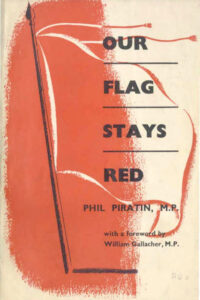 In Our Flag Stays Red (1948) Phil Piratin – the Communist Party MP for Mile End – wrote an account of the 1940 occupation of the Savoy Hotel.
In Our Flag Stays Red (1948) Phil Piratin – the Communist Party MP for Mile End – wrote an account of the 1940 occupation of the Savoy Hotel.
This is just one of the many stories I came across in the research for the Marienbad – my post about Fritz Stingl and his escape from Czechoslovakia in 1939.
Fritz was hired as a waiter at the Savoy in January 1940 after some months as a farm laborer where he was underpaid and poorly treated on the Richardson farm in Didcot but learned to milk cows and then better treated at a farm in Pangbourne where he helped with the harvest, learned to drive the harvester and pile the sheaves on a horse-drawn cart, and delivered potatoes by van.
Fritz got the Savoy job because of his connection with the Hotel Sroubek in Wenceslas Square, Prague. This was the hotel where in 1939 Nicholas Winton set up headquarters for organizing his part in the Kindertransport. But that’s another story.
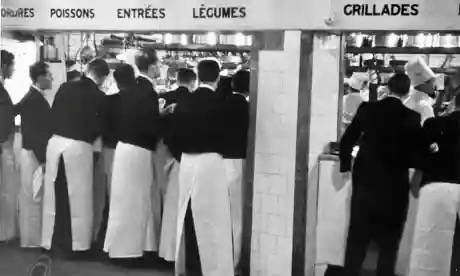
Fritz was at the Savoy through the early months of the London Blitz. It began at about 4:00 in the afternoon on September 7, 1940, when German planes appeared over London. For two hours, close to 350 German bombers (escorted by over 600 fighters) dropped explosives on East London, targeting the docks in particular. The intention was to completely destabilize the economic infrastructure of London including docks, factories, warehouses, and railway lines. It was a densely populated working-class area with very poor shelter provision.
The Savoy, by contrast, had perhaps the most luxurious air raid shelter anywhere. When the war began – and long before the bombs began to fall – the Savoy converted the Abraham Lincoln Room and the adjoining Pink and Green Rooms into shelters. Two hundred beds were installed in separate curtained bays with spaces set aside for conference areas so that important people could continue to work through a raid. It was air-conditioned, gas-proof, and sound-proof and had its own designated serving staff, wardens, and nurses. There was a coffee room and a small bar one floor up.
These photos are from a spread in the Australian pictorial magazine Pix:
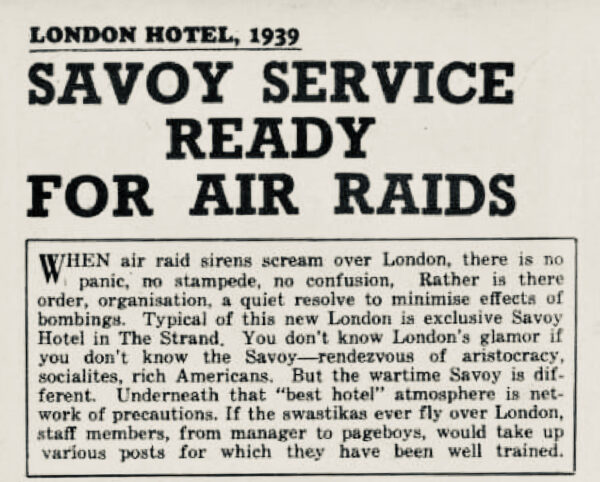
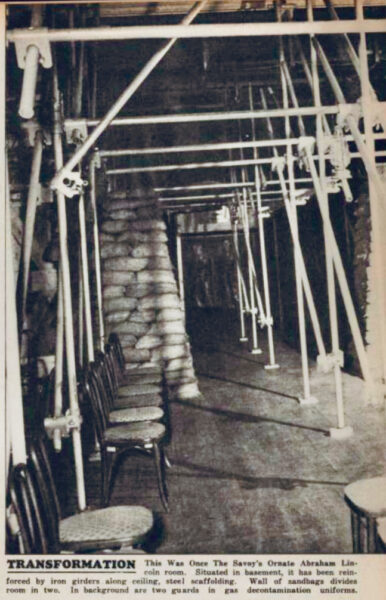
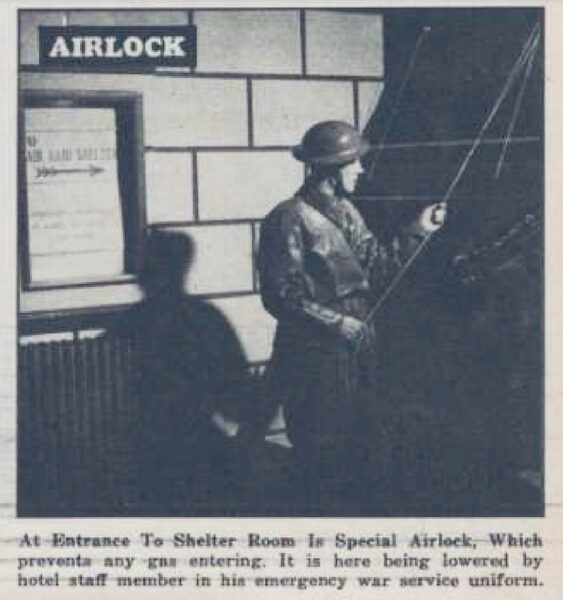
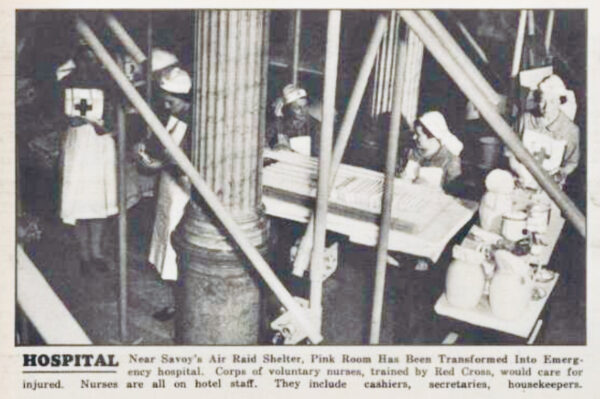
This photo by Marvin Breckinridge shows Savoy guests with their gas masks in the shelter on the day war was declared – September 3, 1939. The sirens sounded an air raid alert immediately after. This time it was only a drill.
The Snore Detectives
According to a story in the Daily Mirror, Savoy shelters were even protected from the nuisance of snoring sleepers. Offending noise makers were gently woken up by specially appointed snore-detecting staff and escorted to sound-proof cubicles so they could no longer annoy fellow shelterers.
Hotel guests were afforded the best possible degree of safety and service.
Ordinary Mortals and the Class War in Wartime
The same was not the case for the people of East End whose shelters were inadequate, – unsafe, unsanitary, and overcrowded – and who were prevented from taking shelter in the underground stations. Government officials believed that if people were allowed to use the deep underground stations they would develop a defeatist ‘shelter’ mentality.
After nights of heavy bombing, Stepney Communist Party organizer Phil Piratin led a march to the Savoy to protest the difference in shelter accommodations for rich and poor.
“The contrast between the shelter conditions for the rich and the poor called for exposure. This was done. When the blitz had continued for some days, we in Stepney took the initiative. One Saturday evening we gathered some seventy people, among them a large sprinkling of children, and we took them to the Savoy Hotel. We had heard from building workers of the well-constructed and luxurious shelter which had been built for their guests. We decided that what was good enough for the Savoy Hotel parasites was reasonably good enough for Stepney workers and their families. We had an idea the hotel management would not see eye to eye with this proposition, so we organised the ‘invasion’ without their consent.”
Within minutes – and with the help of sympathetic waiters – the group had invaded and occupied the Savoy Hotel shelter:
“In fact, there was some effort to stop us, but it was only a matter of seconds before we were downstairs, and the women and children cam streaming in afterwards. While the management and their lackeys were filled with consternation, the visitors from the East End looked round in amazement. ‘Shelters,’ they said, ‘why we’d love to live in such places!’ Structurally, the lower ground floor had been strengthened with steel girders and by other means. But the appearance of the place! There were three sections. In each section there were cubicles. Each section was decorated in a different colour, pink, blue and green. All the bedding, all the linen, was of course the same uniform colour. Armchairs and deck chairs were strewn around. There were several ‘nurses’ – you could easily recognise them. One happened to be standing around and she was wearing the usual nurse’s white outfit, with a big red cross on he bosom. We were not quite sure what she was supposed to be nursing…
…We had earlier appointed our marshals to take care of all our people. They immediately made contact with the waiters, and asked for water and other such provisions. The waiters were most helpful. We were expecting trouble; we knew that the management was not going to allow us to sit there, just so easily. After a few minutes the police came. A plain-clothes officer said to me, ‘What is it all about?’ I explained. He said: ‘We will have to get you out.’ I said ‘OK – I’m curious to see what you do with the women and children.’ (The blitz was on). I said: ’Some of these men have seen mass murder, God help you if you touch the women and children.’ He wasn’t very happy. They tried intimidation, such as calling for identity cards, but we sat there.”
During all this, an air raid siren sounded, and the Savoy Hotel manager realized that that could not be seen to send the protesters out into the streets and he allowed them to stay until the All clear sounded and they could safely be escorted out.
Tea and Bread And Butter
“The management was in a dilemma. They urged the police to throw us out. We were able to impress the management that any such attempt would meet with some opposition, and that some of his guests in the dining room were likely to be disturbed. The manager left. He agreed to ignore us; that was what we wanted. Then we settled down. The first thing the marshals did was to call for refreshments. Many of our people had sandwiches with them, and therefore we asked one of the waiters to provide tea and bread butter. The waiter explained that they never served tea and bread and butter, and in any case the minimum price for anything was 2 shillings 6 pence. We said to the waiter: ‘We will pay you 2 pence a cup of tea and 2 pence a portion of bread and butter, the usual price in a Lyons restaurant. Three of four of the waiters went into a huddle, with one in particular doing the talking. He was evidently convincing the others. How they convinced the chef and management. I do not know, but within a few minutes, along came the trollies and the silver trays laden with pots of tea and bread and butter. The waiters were having the time of their lives. They were obviously neglecting their duties, standing around, chuckling and playing with the children.” – Phil Piratin
As far as I can tell searching the newspaper archives, most of the British press ignored the protest although Cassandra in the Daily Mirror had a commentary. The Savoy, however, was an international press hub. Bombed out of its own offices, the New York Times bureau had set up living and working quarters at the hotel and they were on hand to report the event.
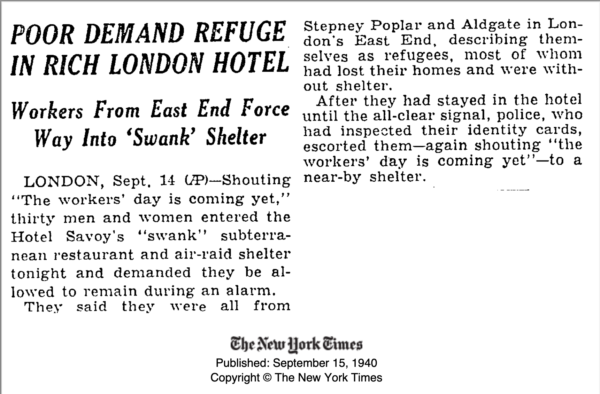
“Under Communist Guidance”
James Reston – London correspondent for the NYTimes also filed a story on September 15th, 1940.
The story of Reds running amok and making demands was “balanced” with a picture of the king speaking with bombed-out east Londoners. In some parts of London and other blitzed cities, tensions were running high and the government knew it.
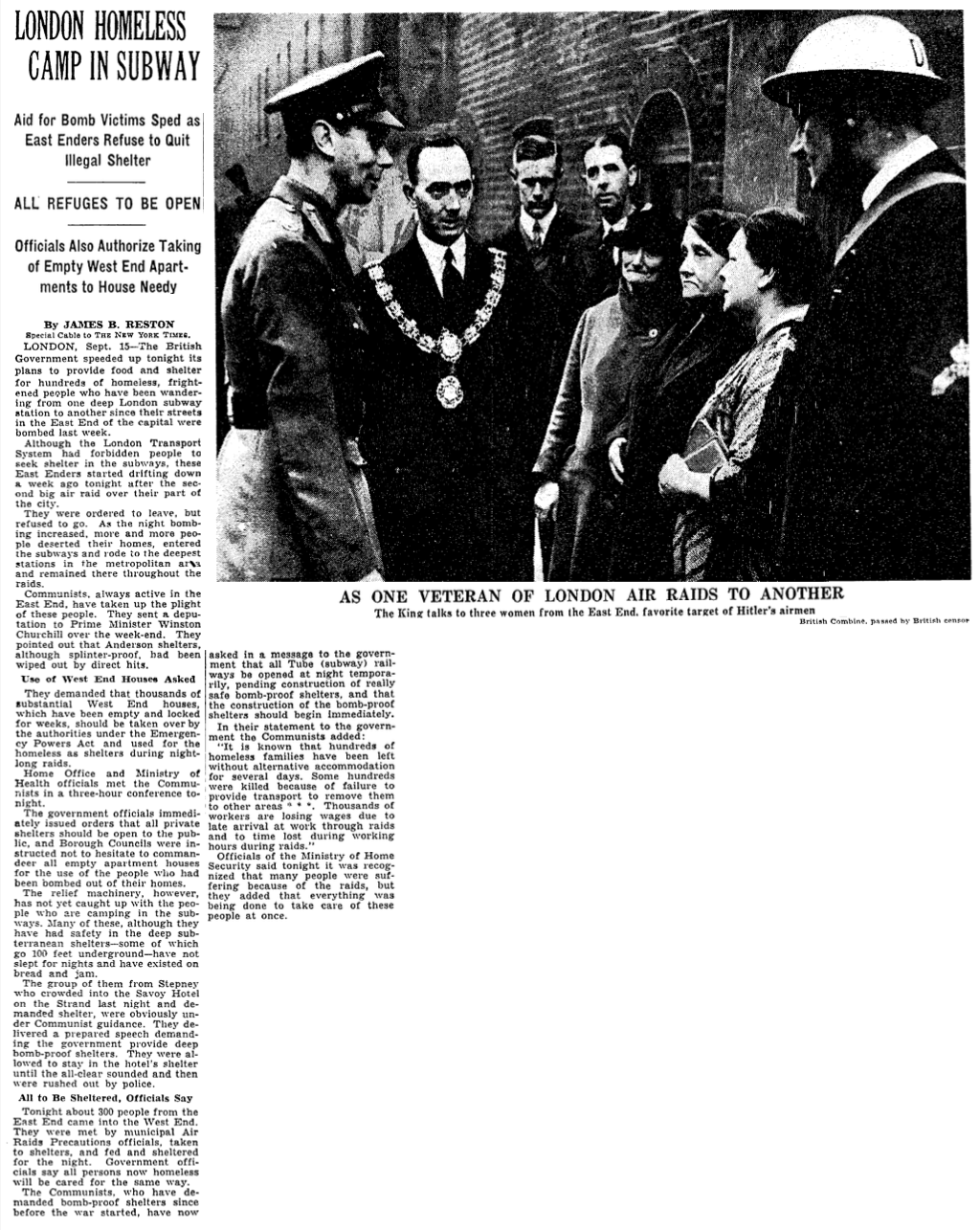
As the news report indicates, this protest – and the one at Liverpool Street Station – had an immediate impact. The Communist Party had succeeded in its objective. At St Pancras, they organized a picket of Carreras, the tobacco factory, demanding its shelter – capable of holding 3,000 – be opened to the public at night.
In Walthamstow Councillor Bob Smith went with some homeless “bombed out” families and occupied empty houses, and similar actions took place in Chiswick (Heathfield Court) and Kensington.
“As a result, the Home Office took special steps to improve conditions in the Tilbury shelter and others. But this militant action led to further developments. A demand had been made for the Tubes to be made available as shelters. The Home Secretary, Mr Herbert Morrison, said that this was impossible. The only valid reason he could give was that children might fall on to the line and be killed. This was not a very impressive argument, when you consider the hundreds who were being killed because they had no shelter. The police were given instructions to allow no-one to use the Tubes for shelter. Loiterers were moved on by the police. The Communist Party decided that the Tubes should be open for shelters. This was done.
Two or three days after the Savoy incident preparations were made to break open the gates of the Tubes which the police were closing immediately the air-raid siren was sounded. At a number of stations these actions were taken. Various implements such as crowbars happened to be available, and while the police stood on duty guarding the gates, they were very quickly swept aside by the crowds, the crowbars brought into action, and the people went down. That night tens of thousands sprawled on the tube platforms. The next day, Mr Herbert Morrison, solemn as an owl, rose to make his world-shattering announcement: the Government had reconsidered its opinion in the matter of the Tubes being sued as shelters. From now onwards, they would be so employed. They were expected to accommodate 250,000. Arrangements would be made for refreshment and first-aid facilities. Later. Bunks were being installed. ‘The Government had reconsidered the matter.’ They had indeed! They had been forced to by the resolute action of the people of London which they had been powerless to prevent.” – (Phil Piratin, Our Flag Stays Red).
In August 1945, The Workers Star (Perth, Australia) celebrated Piratin’s election victory with a reminder of the protest.
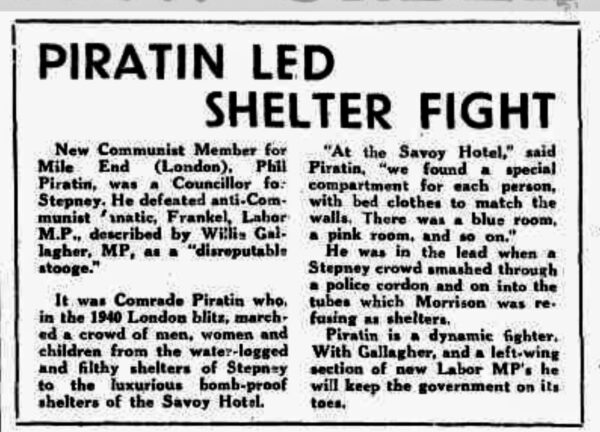
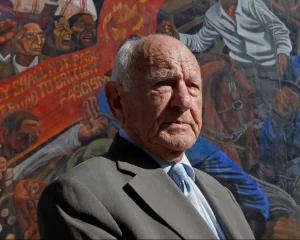 The legendary anti-fascist Max Levitas who had battled against Oswald Mosley at Cable Street 1936 was also part of the Savoy protest.
The legendary anti-fascist Max Levitas who had battled against Oswald Mosley at Cable Street 1936 was also part of the Savoy protest.
The NYTimes published a wonderful tribute to him by Daniel Trilling in 2018
Lessons From a 103-Year-Old Jewish East London Socialist
Max Levitas wasn’t just an activist. He was a neighbor.
The featured image is from Haines, Wilfred Stanley; Seventh September 1940; Grundy Art Gallery; 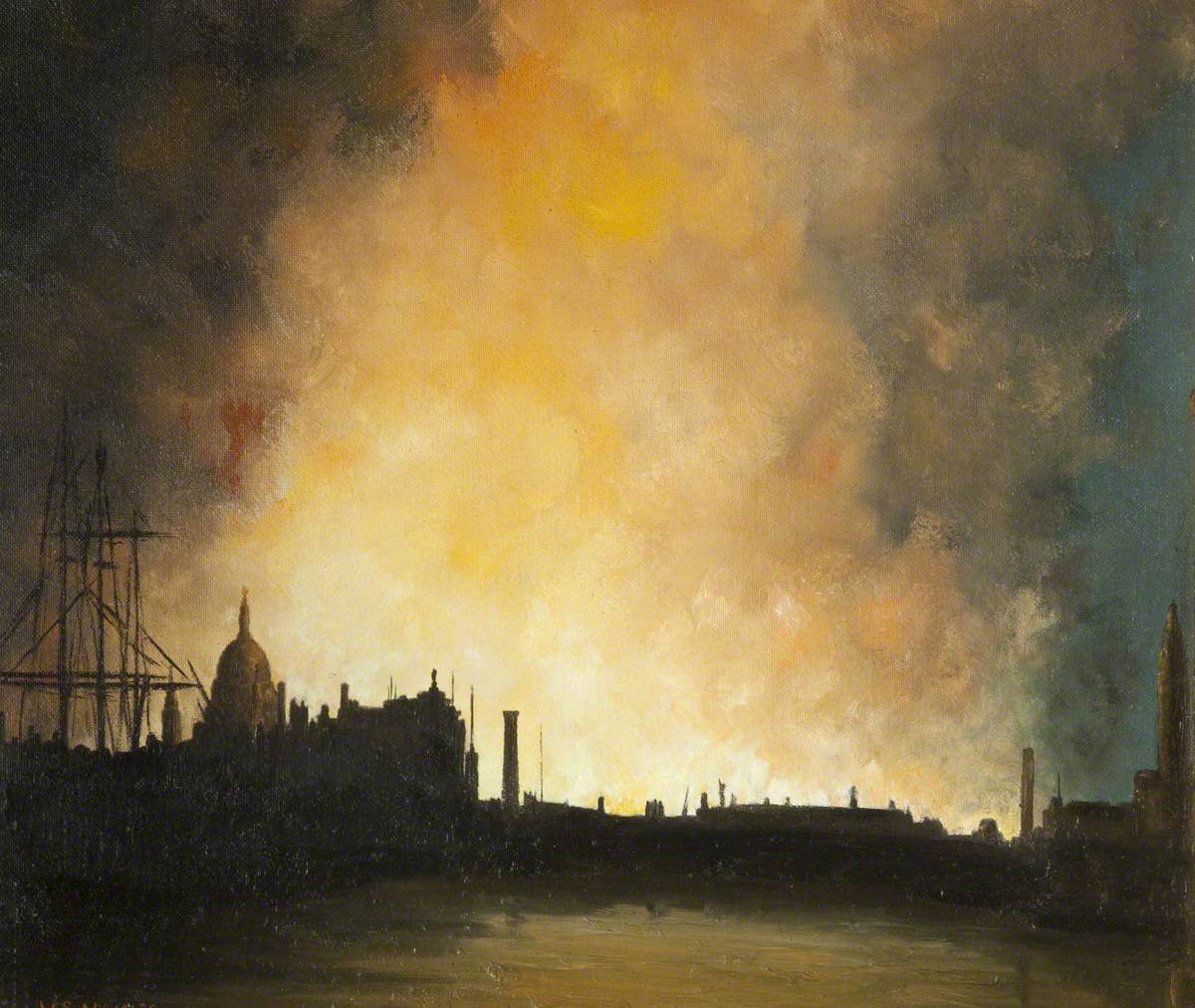
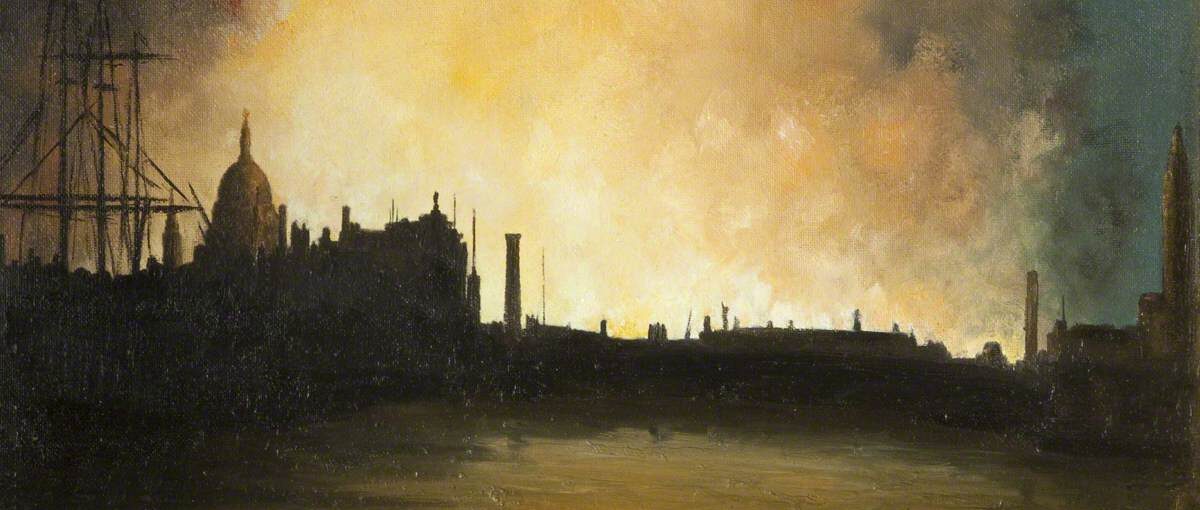
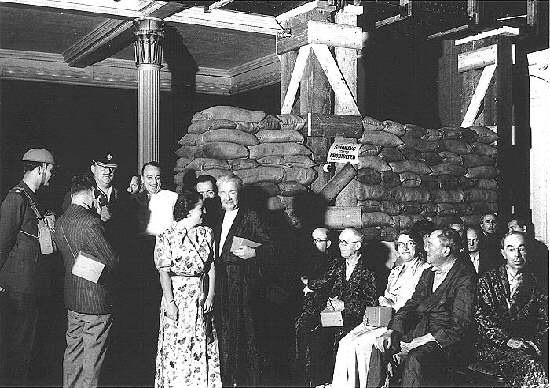


Thanks sir for sharing this article
Glad you liked Harvest and the Scholar and Tiger in the Night.
Gwen.
I like taking a regular dip into your archives and savouring a few poems! Always rewarding.
What a disgrace that was. Bomb shelters were not as numerous as they should have been anywhere.
Thanks for this stirring account, Josie.
Gwen.
The government had to be shamed into opening the underground stations.
Good dug up history from WWII . I didn’t know the tubes were off limits before they were outfitted to accomodate Londoners from the bombings. And the Savoy! Who knew? I liked the picture of some of the old duffs sitting around in their bathrobes.
Easy to imagine Noel Coward sitting there in an exquisite silk dressing gown!
I wouldn’t exactly say Noel Coward’s gown (1 minute & 19 seconds into this short clip) is exquisite, nor is he sitting, but it IS a “Conversation Piece” (the title of one of his stage shows).
[youtube https://www.youtube.com/watch?v=ZxAGbWSC7Nc&w=789&h=664%5D
Thanks for the link. just watched it and then found this in the Guardian.
Coward’s country house was requisitioned for the war effort and so
“He moved to the Savoy Hotel; there he found other similarly dispossessed chums such as Margot Asquith. The blitz was in full swing; he was now right at the centre of the British people’s experience of war, though of course, in a very Noël Coward sort of way. Supping at the Savoy on a Saturday night in April 1941, he noted: “Had a few drinks. Pretty bad blitz, but not as bad as Wednesday. A couple of bombs fell very near during dinner. Wall bulged a bit and door blew in. Orchestra went on playing, no one stopped eating or talking. Blitz continued. Carroll Gibbons played the piano, I sang, so did Judy Campbell and a couple of drunken Scots Canadians. On the whole a strange and very amusing evening. People’s behaviour absolutely magnificent. Much better than gallant. Wish the whole of America could really see and understand it. Thankful to God that I came back. Would not have missed this experience for anything.'”
And of course – the Savoy theater was right there on site!
Thanks for this, Josie, for too long an obscure aspect of the Blitz which should not only be better known but shouted from the rooftops.
Raising a cup of tea in salute to Phil Piratin. Great story, Josie, thank you for sharing it.
Extremely interesting. Money talks and privilege (often) prevails, but sometimes right makes might (rather than vice versa) if right is persistent enough. Thanks for this story which demonstrates it.
I think it is generally true that there is/ was / and never will be any “justice” without struggle.
(Have to channel that inner Woody Guthrie for the songs to go with).
The powers that be knew in 1940 that if they did not have popular support for the war then it would be over. The “people’ and popular opinion had to be on side if this war was to be won.
No surprise then that the 1943 Beveridge report promised post-war social reforms.
And certainly, no wonder why the British electorate – and especially the military vote – rejected Churchill and the Tories in the 1945 election.
Fascinating piece of history. I especially like the idea of ‘snore police’, and reckon we should bring them back. How many nights’ sleep get stolen due to snorers, eh? It’s criminal 🙂
I’ve also read accounts of people whose job it was to wake snorers sleeping on the underground platforms during the Blitz. It was a real problem apparently. (Less so at the Savoy of course!)
Somehow no-one ever mentioned to me that the government had to be persuaded to allow people to shelter in the underground stations. Yet it does not surprise me. The poor have always been expendable, after all. In the vastness of the Universe, I wonder if there is a species less screwed up.
Yes. That is an important piece of this history.
We are all familiar with the pictures of Londoners sleeping in the underground during the Blitz. But not so well known is the fact that they had to fight for that “privilege”.
Most impressive research.
Sheila Morris´s last blog post ..a letter to our granddaughters about love
Thanks, Sheila.
It’s always fun to look into newspaper archives. They tell such an interesting (and often distorted ) sense of history.
But one thing they do for sure is telling what was considered newsworthy and acceptable (and, by omission, what was not.) They are a reliable record. But whose record is it?